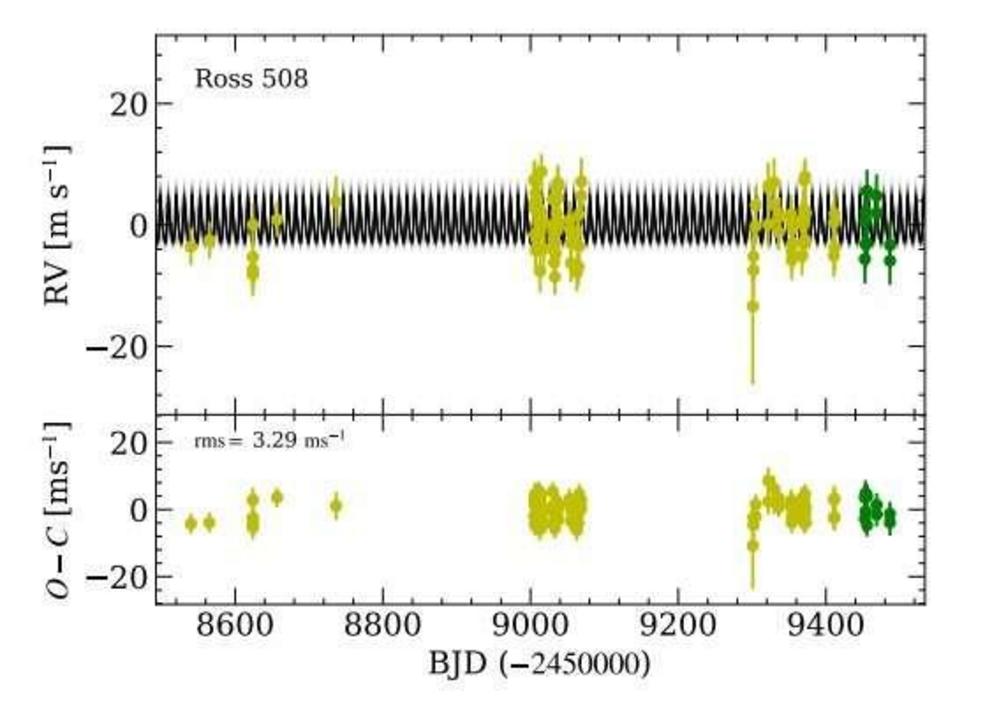Super-Earth exoplanet orbiting nearby star discovered
Ross 508: observed RVs and the best-fit orbital solution.
An international team of astronomers reports the discovery of a new super-Earth exoplanet orbiting a nearby M-dwarf star known as Ross 508. The newly found alien world, which received designation Ross 508 b, turns out to be at least four times more massive than our planet. The finding was detailed in a paper published May 24 on arXiv.org.
"Super-Earths" are planets more massive than Earth but not exceeding the mass of Neptune. Although the term "super-Earth" refers only to the mass of the planet, it is also used by astronomers to describe planets bigger than Earth but smaller than the so-called "mini-Neptunes" (with a radius between two to four Earth radii).
Now, astronomers led by Hiroki Harakawa of the Subaru Telescope have discovered a new planet of the super-Earth class. Using the InfraRed Doppler (IRD) instrument on the Subaru 8.2-m telescope, they conducted radial velocity (RV) measurements of Ross 508—an M dwarf of spectral type M4.5, located some 36.5 light years away.
"We showed that the M4.5 dwarf Ross 508 has a significant RV periodicity at 10.75 days with possible aliases at 1.099 and 0.913 days. This periodicity has no counterpart in photometry or stellar activity indicators, but is well-fit by a Keplerian orbit due to a new planet, Ross 508 b," the researchers explained.
The newly found exoplanet Ross 508 b has a minimum mass of four Earth masses and orbits its host every 10.75 days at a distance of about 0.053 AU from it. According to the astronomers, this indicates an orbit-averaged insolation of about 1.4 times the Earth's value, placing this planet near the inner edge of Ross 508's habitable zone.
The exact orbital eccentricity of Ross 508 b is still unknown and further studies on this could provide important information about the planet's origin. The researchers suppose that Ross 508 b may have formed beyond the snow line (about 0.16 AU) and undergone inward Type I migration. They noted that even if the eccentricity of a migrating alien world is initially high, it can be damped by the force exerted on the planet by density waves.
The parent star Ross 508 has a radius of about 0.21 solar radii and a mass of approximately 0.18 solar masses, which yields a density at a level of 26.5 g/cm3. The star has an effective temperature of 3,071 K and its metallicity is estimated to be -2.0.
Summing up the results, the authors of the paper hope that future surveys with IRD and other high-precision near-infrared spectrographs will enable the discovery of planets around more stars like Ross 508.
"Our discovery demonstrates that the near-infrared RV search can play a crucial role to find a low-mass planet around cool M dwarfs like Ross 508. (...) Exoplanet exploration will be advanced by the other late-M dwarf RV surveys using high-dispersion spectrographs, such as HPF, CARMENES, and SPIROU, as well as exoplanet surveys using the transit technique from space (e.g., TESS) and the ground (e.g., SPECULOOS)," the researchers concluded.
More information: A Super-Earth Orbiting Near the Inner Edge of the Habitable Zone around the M4.5-dwarf Ross 508, arXiv:2205.11986 [astro-ph.EP] arxiv.org/abs/2205.11986

